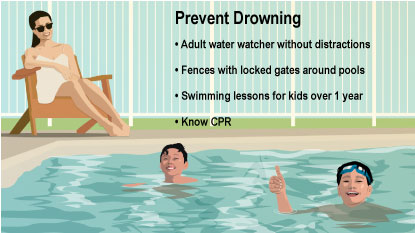Your child was underwater for a short time but was rescued before there was any damage to their body or brain. They were checked in the emergency room and can now be watched at home.
Fortunately, your child was rescued. But to protect them and everyone in your family, this is a good time to review water safety guidelines.


Water Safety Guidelines
Assign a Water Watcher
The water watcher should:
Use Fences/Alarms/Covers
Have Kids Take Swim Lessons
Check with your local recreation center or visit the Red Cross website for classes taught by a qualified instructor in your area.
Learn CPR
Visit the Red Cross website for classes taught by a qualified instructor in your area.
Use Life Jackets
Children and adults should wear Coast Guard–approved life jackets while on a boat (even if they can swim).
No Alcohol or Drugs
Do not use alcohol and/or drugs while driving a boat, acting as a water watcher, or swimming.
Home Safety
To prevent drownings in and around your home:
Talk to Teens
Even teens who are strong swimmers are at risk of drowning. Be sure your teen knows how to swim. And talk to them about never swimming alone, only swimming where a trained lifeguard is on duty, and never drinking alcohol or using drugs while near or in water.


Your child:

What happens if my child develops breathing symptoms? Because your child had little to no symptoms in the emergency room, it is very unlikely that they will get symptoms at home. But very rarely, a child can get symptoms hours after an underwater rescue. If your child gets symptoms later, they need treatment right away.
Who is most at risk of drowning? Drowning is more likely in young children, kids who don't know how to swim, kids who swim without proper adult supervision, and people who have seizures. Drinking alcohol while boating or swimming also increases the risk of someone drowning.